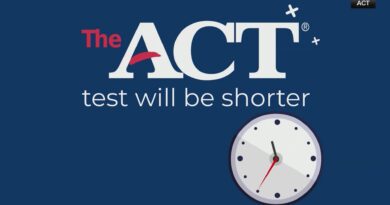Average SAT, ACT Scores & Acceptance Rates at Top U.S. Universities (2025)
Getting into the top universities in the United States is one of the most competitive challenges for students worldwide. Every year, thousands of highly qualified applicants apply to Ivy League schools, elite STEM universities, and top liberal arts colleges, but only a small fraction receive admission offers. Test scores like the SAT and ACT continue to play an important role in this process. While a perfect score does not guarantee admission, strong scores signal academic readiness and can help your application stand out.
However, what many students and parents don’t realize is that SAT and ACT scores are just one part of the admissions equation. For instance, a school like Minerva University admits only about 1% of applicants, meaning even students with 1550+ SAT scores may face rejection, while others with slightly lower scores can still be admitted if they excel in essays, interviews, leadership, or unique experiences. At Ivy League schools, the score ranges, often 1500+ SAT and 34+ ACT, act more as a filter than a deciding factor. Once you’re in the range, other elements like personal essays, extracurriculars, research, and recommendations carry the most weight.
This report breaks down the SAT and ACT score ranges, averages, and acceptance rates for some of the toughest U.S. universities. It also explains what these numbers really mean for applicants, why some schools prioritize problem-solving or creativity over test scores, and how to strategically use SAT or ACT results to maximize your chances of getting in. Whether you’re targeting Harvard, MIT, Stanford, or elite liberal arts colleges, understanding how test scores fit into the bigger admissions picture is crucial for building a winning application strategy.
Acceptance Rates, SAT & ACT Scores (Top U.S. Universities)
| College Name | Acceptance Rate | SAT RANGE | SAT Average | ACT RANGE | ACT Average |
| Minerva University | 1% | 1450-1570 | 1515 | 33-35 | 34 |
| California Institute of Technology | 2.69% | 1530-1580 | 1525 | 35-36 | 35 |
| Harvard University | 3.24% | 1540-1580 | 1553 | 34-36 | 35 |
| Stanford University | 3.68% | 1550-1580 | 1553 | 33-35 | 35 |
| Columbia University in the City of New York | 3.95% | 1540-1580 | 1540 | 34-35 | 35 |
| Massachusetts Institute of Technology | 3.96% | 1570-1580 | 1560 | 35-36 | 35 |
| Yale University | 4.57% | 1540-1580 | 1547 | 33-35 | 34 |
| Brown University | 5.06% | 1540-1580 | 1547 | 34-36 | 34 |
| University of Chicago | 5.43% | 1540-1580 | 1532 | 34-35 | 34 |
| Princeton University | 5.7% | 1540-1580 | 1546 | 33-35 | 34 |
| Duke University | 6.35% | 1530-1570 | 1554 | 34-35 | 34 |
| Dartmouth College | 6.38% | 1540-1580 | 1539 | 33-35 | 34 |
| University of Pennsylvania | 6.5% | 1540-1570 | 1546 | 34-35 | 34 |
| Vanderbilt University | 6.67% | 1530-1570 | 1546 | 34-35 | 35 |
| Northeastern University | 6.8% | 1500-1550 | 1505 | 33-35 | 34 |
| Swarthmore College | 6.93% | 1500-1560 | 1507 | 32-35 | 34 |
| Pomona College | 7.02% | 1520-1560 | 1520 | 33-35 | 34 |
| Northwestern University | 7.21% | 1530-1570 | 1526 | 33-35 | 35 |
| Johns Hopkins University | 7.25% | 1550-1570 | 1553 | 34-35 | 34 |
| Amherst College | 7.26% | 1480-1550 | 1513 | 32-35 | 33 |
| Cornell University | 7.47% | 1530-1570 | 1527 | 33-35 | 34 |
| Colby College | 7.61% | 1470-1540 | 1501 | 32-34 | 33 |
| Williams College | 8.5% | 1530-1570 | 1540 | 34-35 | 34 |
| Rice University | 8.68% | 1530-1570 | 1546 | 34-36 | 35 |
| Barnard College | 8.79% | 1490-1550 | 1495 | 32-34 | 33 |
SAT and ACT Scores for Top U.S. Universities: What They Really Mean
1. The Role of Score Ranges
Every top university in the United States publishes an average SAT and ACT score range for admitted students. These ranges usually represent the middle 50% of the incoming class. For example, Yale reports an SAT range of 1540–1580, which means that half of their admitted students scored within this band. However, 25% of successful applicants scored below it, and 25% scored above it. This proves that test scores are not the only deciding factor. They work more like filters—helping admissions officers understand academic readiness—while the final decision also depends on essays, extracurriculars, and unique personal qualities.
2. Score Ranges Across Institutions
Ultra-Elite (Acceptance Below 4%)
Universities such as Harvard, MIT, Stanford, Caltech, and Columbia are the most selective. Their SAT range typically falls between 1540–1580, with ACT scores between 34–36. Students applying here need to understand that having a score below 1530 makes admission very unlikely unless they bring something extraordinary to the table—such as international research recognition, national-level awards, or athletic achievements.
Highly Selective (4–6% Acceptance)
Schools like Brown, Princeton, Duke, Dartmouth, UPenn, and Johns Hopkins accept only a small percentage of applicants. Their SAT range is usually 1530–1570, while ACT averages hover around 34–35. A 1540 SAT or 34 ACT score generally places students in the competitive range, but even here, admissions officers look carefully at leadership, initiative, and academic passion.
Selective (6–8% Acceptance)
Institutions such as Northwestern, Vanderbilt, Rice, Swarthmore, Cornell, Pomona, and Amherst report SAT ranges between 1500–1570 and ACT scores of 33–35. Students with scores above 1500 have a realistic chance of admission, but what truly matters is showing curiosity and intellectual depth through research projects, essays, or strong recommendations.
Competitive but Broader Pool (7–9% Acceptance)
Colleges such as Williams, Colby, Barnard, UCLA, and Northeastern fall into this range. Their SAT scores typically range between 1470–1550, while ACT averages sit between 32–34. These universities provide slightly more flexibility for applicants. A strong essay, community involvement, or leadership record can make up for a slightly lower test score, showing that a well-rounded profile often carries more weight.
3. What This Means for Students
One of the most common misconceptions is that perfect test scores guarantee admission. At universities like Stanford, which report SAT scores of 1550–1580, thousands of students apply with flawless results. Yet, many of them are rejected because their applications lack unique qualities. Meanwhile, students with lower scores—sometimes even below 1500—are admitted because they excel in other areas such as entrepreneurship, arts, or service. The data makes it clear: while test scores matter, they are only one part of a much bigger picture.
4. SAT vs. ACT: Which Is Better?
Both SAT and ACT are equally accepted by all top U.S. universities. The right test depends on a student’s natural strengths. The SAT favors those who are strong in math and reading comprehension, while the ACT is better for students who are quick at handling multiple sections, including science. Colleges do not prefer one over the other. A 35 ACT score and a 1550 SAT score are treated with equal weight. What matters is consistency and how well the score aligns with the rest of the application.
5. Guidance for Maximizing Chances
Set a Target Score: Students should aim for at least 1530+ SAT or 34+ ACT to remain competitive across most selective universities. For ultra-elite schools like MIT and Harvard, the closer you are to 1550+ SAT or 35 ACT, the stronger your profile looks.
Choose the Right Exam: Take practice tests for both SAT and ACT early in high school. Whichever test feels more natural should become your focus. Preparing deeply for one exam often produces better results than dividing time between both.
Build Beyond the Score: Admissions officers use test scores to confirm readiness, but what convinces them are essays, recommendation letters, extracurricular leadership, and authentic stories of impact. For example, Princeton values service, while the University of Chicago prioritizes creativity in essays. Students must tailor their applications accordingly.
Don’t Be Afraid of Lower Scores: Many students with slightly below-average scores are still admitted if they stand out in other ways. A 1490 SAT may still win admission if paired with outstanding research, community projects, or national-level recognition. In contrast, a perfect 1600 SAT without personality or achievements may not go far.
SAT and ACT scores are important—but they are only the entry ticket. Once you cross the basic score threshold, your essays, leadership, and personal story decide your admission. Since most top schools report overlapping ranges of 1500–1570 SAT and 33–35 ACT, the smartest strategy is to reach a solid score, then focus on building a powerful overall application.
Analysis: What This Data Tells Us
Minerva – The Toughest Admission in the World
When people think of the hardest universities to get into, names like Harvard, MIT, or Stanford immediately come to mind. Yet, statistically, Minerva University surpasses them all. With an acceptance rate just above 1%, it is more selective than any Ivy League school. What makes Minerva unique is its global admissions model. Instead of standardized test scores, the university emphasizes critical thinking, scenario-based assessments, and real-world problem-solving. This means even students with a 1450 SAT can be admitted, while others with 1550+ SATs may be rejected if they fail to show creativity and leadership. For students, the lesson is clear: while test scores are important, they are not everything—your ability to think differently and prove adaptability can open doors at the world’s most selective institutions.
The Ivy League Cluster – Scores as a Filter, Not a Ticket
Harvard, Yale, Princeton, Columbia, Brown, UPenn, Dartmouth, and Cornell make up the Ivy League, and their data shows a consistent pattern. The majority of admitted students fall within an SAT range of 1500–1535 and ACT averages of 34–35. These numbers indicate that test scores serve as a basic filter, ensuring applicants can handle academic rigor. But what truly decides admission are factors such as essays, teacher recommendations, community leadership, and intellectual depth. For instance, Harvard values “well-rounded but with a spike,” while Yale emphasizes creativity and Princeton rewards community service. Students aiming for the Ivy League should not obsess over chasing a perfect 1600 SAT. Instead, they should focus on pairing strong scores with personal achievements and authentic stories that show what makes them stand out.
STEM-Driven Schools – Beyond Just Numbers
Institutions such as MIT, Caltech, and Harvey Mudd are dream destinations for STEM-focused students, but their admissions go far beyond SAT or ACT scores. Although their admitted ranges are some of the highest (often 1530–1580 SAT and 35–36 ACT), these schools value problem-solving ability, technical innovation, and hands-on research more than anything else. For example, a student who has built a robotics prototype, participated in hackathons, or conducted lab research often stands out more than one with a perfect 1600 SAT. These schools want “makers”—students who can apply knowledge to real-world problems. For applicants, the best strategy is to complement strong test scores with tangible achievements like science fair awards, published research, or engineering projects.
Specialty Schools – Talent Over Test Scores
Not every selective school weighs standardized test scores heavily. For institutions such as the Curtis Institute of Music, The Juilliard School, and the U.S. Naval Academy, admissions hinge on talent, service, or leadership rather than SAT/ACT results. Curtis and Juilliard primarily evaluate students on auditions and artistic potential, while the Naval Academy requires congressional nominations, physical fitness tests, and proven leadership qualities. This shows that test scores are not universal currency. For students applying to such schools, the focus should shift toward portfolio strength, auditions, service records, or fitness preparation, depending on the program. Strong SAT/ACT scores may help, but they rarely define the outcome.
Liberal Arts Elites – Essays and Intellectual Depth Matter Most
Selective liberal arts colleges such as Amherst, Williams, Swarthmore, Pomona, and Colby consistently report SAT ranges in the 1470–1550 bracket and ACT scores around 32–35. While these scores provide a baseline, what truly matters is a student’s ability to demonstrate intellectual curiosity, strong writing skills, and engagement with humanities or social sciences. These colleges emphasize close-knit communities and want students who bring depth, not just numbers. Essays play a central role here, as admissions officers look for evidence of original thought, passion for learning, and academic exploration. Students should prepare by writing reflective essays, engaging deeply with subjects they care about, and showing initiative in research or creative projects.
The Emerging Trend – Test-Optional Policies and Their Impact
One of the biggest shifts in U.S. college admissions has been the move toward test-optional policies. While many universities adopted this approach during the pandemic, a growing number are now reinstating mandatory SAT/ACT requirements for 2025 and beyond. For students, this means that submitting strong scores is becoming an advantage again. Even in test-optional schools, applicants with high scores often stand out, as it removes doubts about their academic readiness. On the other hand, students with lower scores may still apply without them, but they must compensate with exceptional essays, recommendations, or achievements. The safest strategy is clear: prepare seriously for SAT/ACT, aim for competitive ranges, and submit scores if they reflect your strengths.
Final Guidance – What Students Should Do
This data reveals a powerful truth: test scores open the door, but they don’t secure the seat. For most top universities, being in the 1500+ SAT or 34+ ACT range puts you on the radar. However, what ensures admission is how well you complement those scores with leadership, creativity, essays, and real-world impact. Students should first identify their target schools, study their score ranges, and aim to reach that baseline. Once in range, the real effort should go into building a profile that shows initiative—whether through research, entrepreneurship, community work, or artistic excellence. That is the formula that turns a competitive application into an admitted one.
How to Prepare
- Set a Target Score
- For Ivies and elite private universities: aim for 1530+ SAT or 35 ACT.
- For liberal arts colleges: 1500+ SAT or 34 ACT keeps you competitive.
- For Naval Academy: focus on holistic prep including fitness tests and nomination.
- Start Early
- Begin serious prep in 10th or 11th grade.
- Take diagnostic SAT/ACT to identify your stronger exam. Stick with one for efficiency.
- Structured Preparation
- Use official prep resources (Khan Academy for SAT, ACT.org for ACT).
- Practice with timed full tests every 2–3 weeks.
- Track weak areas and drill them.
- Beyond Tests
- Build research projects, internships, leadership roles alongside test prep.
- Write essays that highlight personal values and unique strengths.
- Secure strong recommendation letters reflecting both intellect and character.
- Submission Strategy
- If your score is above the school’s average, submit it.
- If below, consider test-optional—but compensate with essays, projects, and activities.
Conclusion
SAT and ACT scores remain a powerful metric in 2025 admissions, especially as many top universities reintroduce them as requirements. While elite universities expect 1500+ SAT or 34+ ACT, admissions officers stress that scores are just one piece of a holistic review. To truly stand out, students must pair strong test results with leadership, creativity, research, and community impact.
Key takeaway: Don’t chase a perfect score—chase a balanced application that reflects both academic excellence and personal depth.



